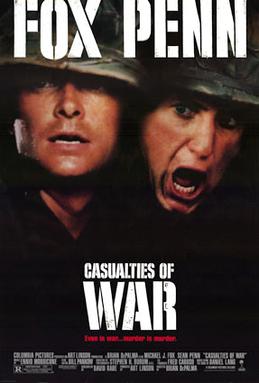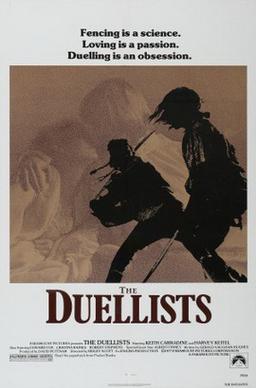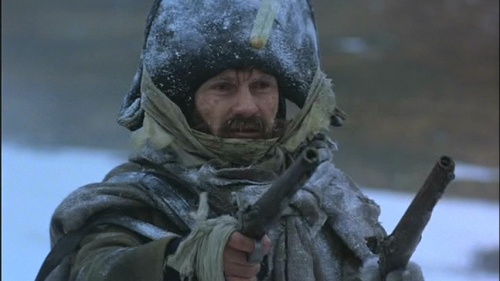GUESS WHICH ARE HISTORY AND WHICH ARE HOLLYWOOD
1.
Meserve saves Eriksson’s life when he
falls into a Viet Cong tunnel during a Viet Cong ambush.
2.
Meserve’s best buddy Brownie is killed
by a grenade thrown by a farmer. Eriksson
hits a grenade with his grenade launcher.
3.
Meserve briefs the men on the
mission. They will go on a long range
patrol to observe a Viet Cong camp. He
proposes kidnapping a Vietnamese girl for sex.
4.
The squad consists of Meserve, his
crony Clark, the malleable Hitch, the new guy Diaz, and the moralistic
Eriksson.
5.
They kidnap a girl from her
hootch. She is forced to carry a pack
and is coughing a lot.
6.
Hitch shoots at a water buffalo that
he mistakes for the enemy and Meserve chews him out.
7.
Eriksson stands up to Meserve who
calls him a queer and threatens him with friendly fire.
8.
The rest of the squad take turns
raping the girl including Diaz who reluctantly participates because peer
pressure.
9.
Eriksson is left alone with the girl
and is planning to leave with her when Clark returns.
10.
From their observation post
overlooking the Viet Cong camp, Meserve orders Eriksson to kill the girl, then
Hitch, then Diaz.
11.
Eriksson opens fire to halt the
murder.
12.
Clark stabs the girl.
13.
There is a wild fire fight with
numerous enemy casualties. A gun boat
arrives and is hit by friendly fire from helicopters.
14.
During the fire fight, the girl tries
to escape down the train track. Everyone
except Eriksson open fire and she is killed and falls to the river bank.
15.
When Eriksson goes to Lt. Riley, Riley
relates his baby at the hospital story and tells him “what happened is the way
things are, so why try to buck the system?”
16.
Eriksson goes to Capt. Hill and is
told that Hill is handling everything, but courts-martial are notoriously
lenient. He is very unsympathetic and
mentions that Meserve did save Eriksson’s life.
17.
Clark attempts to frag Eriksson in the
latrine and Eriksson confronts his tormentors with a shovel.
18.
Eriksson’s talk with a chaplain gets
the courts-martial started.
19.
The four accused get various sentences
with Meserve getting ten years hard labor for murder.
THE ANSWERS
1. Meserve saves Eriksson’s life when he falls
into a Viet Cong tunnel during a Viet Cong ambush. HOLLYWOOD This
crap was put in to start the movie with some action and establish that Meserve
is a good soldier and Eriksson owes his life to him.
2. Meserve’s best buddy Brownie is killed by a
grenade thrown by a farmer. Eriksson
hits a grenade with his grenade launcher.
HOLLYWOOD This scene was totally fabricated,
but Eriksson did once hit a grenade with his grenade launcher.
3. Meserve briefs the men on the
mission. They will go on a long range
patrol to observe a Viet Cong camp. He
proposes kidnapping a Vietnamese girl for sex.
HISTORY Meserve felt the “boom boom” would
be good for unit morale. In reality, he
added that they would kill the girl when they were done with her.
4. The squad consists of Meserve, his crony
Clark, the malleable Hitch, the new guy Diaz, and the moralistic Eriksson. HISTYWOOD The
movie changed the names of the men and gave them Hollywood stock
personalities. There were actually five
men on the mission.
5. They kidnap a girl from her hootch. She is forced to carry a pack and is coughing
a lot. HISTORY
6. Hitch shoots at a water buffalo that he
mistakes for the enemy and Meserve chews him out. HISTYWOOD The Hitch character did take a shot at
a water buffalo, but Sgt. Gervase did not get upset.
7. Eriksson stands up to Meserve
who calls him a queer and threatens him with friendly fire. HISTORY
8. The rest of the squad take turns raping the
girl including Diaz who reluctantly participates because peer pressure. HISTORY No
one showed any reluctance.
9. Eriksson is left alone with
the girl and is planning to leave with her when Clark returns. HISTYWOOD Unbelievably,
Storeby was left alone with the girl, but he did not try to let her escape.
10. From their observation post
overlooking the Viet Cong camp, Meserve orders Eriksson to kill the girl, then
Hitch, then Diaz. HISTYWOOD
During the fire fight, Gervase and Thomas (Clark) began to
worry that the girl would be spotted by Americans. Gervase did not order several men to murder
the girl.
11. Eriksson opens fire to halt
the murder. HOLLYWOOD
12. Clark stabs the girl. HISTORY Thomas
took the girl into the bushes and stabbed her three times.
13. There is a wild fire fight
with numerous enemy casualties. A gun
boat arrives and is hit by friendly fire from helicopters. HOLLYWOOD It
was not much of a fight and only one enemy body was found afterwards.
14. During the fire fight, the
girl tries to escape down the train track.
Everyone except Eriksson open fire and she is killed and falls to the
river bank. HISTYWOOD
The girl did try to escape, but Thomas chased her down and
shot her in the head with his M-16.
15. When Eriksson goes to Lt.
Riley, Riley relates his baby at the hospital story and tells him “what
happened is the way things are, so why try to buck the system?” HISTORY
16. Eriksson goes to Capt. Hill
and is told that Hill is handling everything, but courts-martial are
notoriously lenient. He is very
unsympathetic and mentions that Meserve did save Eriksson’s life. HISTYWOOD Hill
did not so much cover up the crime as try to overlook it. He was right about the probable result of a
court-martial, but he was not belligerent and did not bring up Meserve saving
Eriksson’s like because that had not happened.
Meserve did have a reputation as a good soldier.
17. Clark attempts to frag
Eriksson in the latrine and Eriksson confronts his tormentors with a shovel. HOLLYWOOD There
were some veiled warnings, but Storeby was transferred to a new unit as soon as
he first told his story and there never was any attempt on his life.
18. Eriksson’s talk with a
chaplain gets the courts-martial started.
HISTORY
19. The four accused get various
sentences with Meserve getting ten years hard labor for murder. HISTORY The
movie covers the trials as one when actually there were four separate trials
and Storeby was the lone prosecution witness at each. The movie gets the sentences right, but De
Palma curiously does not add a post script detailing the shameful reduction of
the sentences. All of the convicted
spent substantially less jail time than they were originally sentenced to. I was not able to find out why Gervase was
not charged with rape.
RATING = .58



